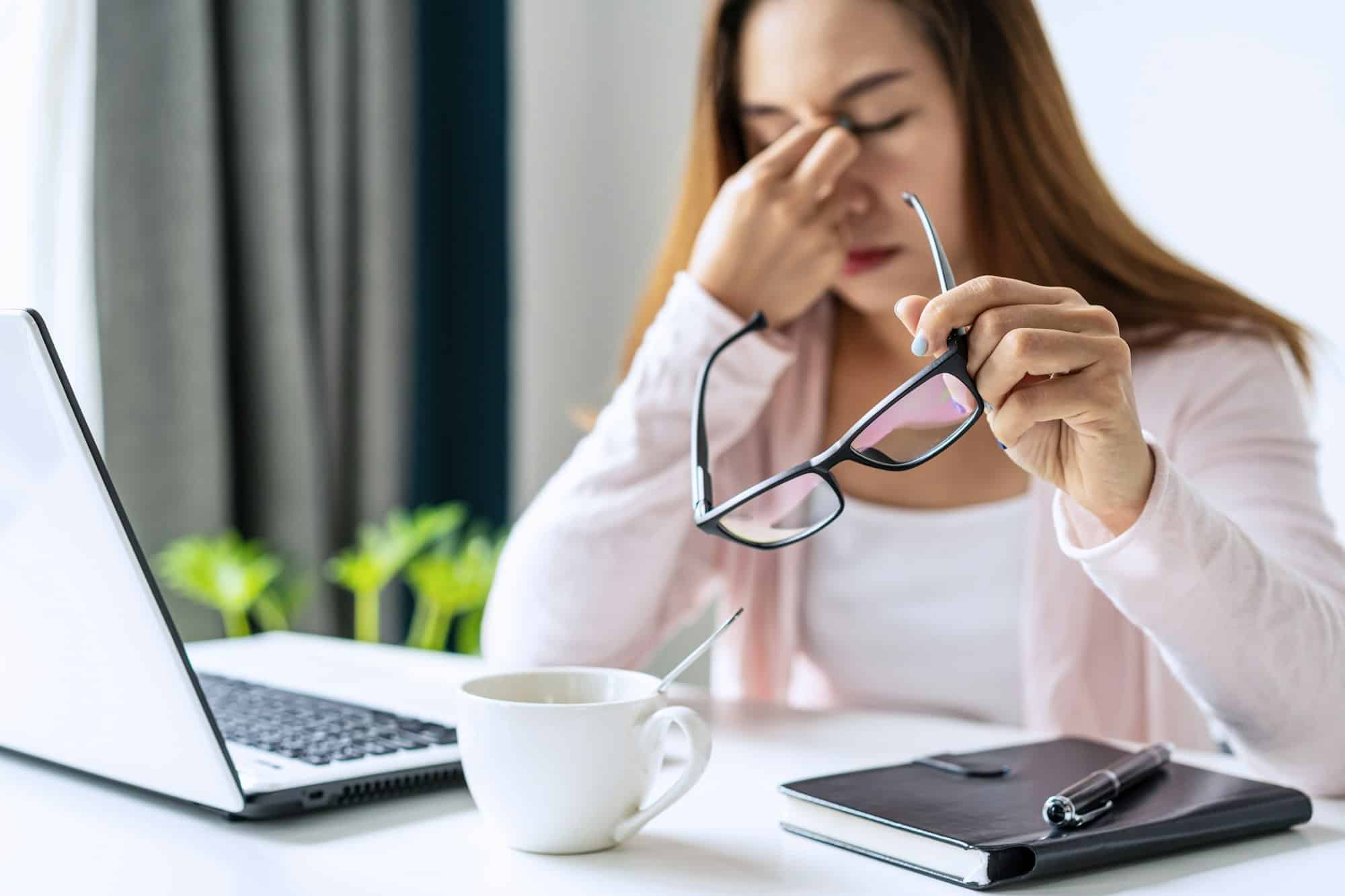In our digital age, technology is ubiquitous in most workplaces. For the increasing number of you who work remotely, screens are an integral part of your working life. You’re constantly connected to devices for work, communication, and leisure. But is this constant exposure to digital screens affecting your eyes?
Indeed, prolonged periods of screen time can lead to a condition known as digital eyestrain. This is a common issue faced by remote workers worldwide. As work-life increasingly shifts from the office to the digital realm, it’s essential to understand how to manage and reduce the risk of digital eyestrain effectively.
Also to discover : Can Regular Facial Muscle Exercises Improve Skin Tone and Counteract Aging?
With this article, we aim to walk you through the symptoms of digital eyestrain, the cause of this condition, and best practices to manage it.
Understanding Digital Eyestrain
Before delving into the ways to manage digital eyestrain, let’s discuss what this condition entails. Digital eyestrain, also known as computer vision syndrome, is a group of eye and vision-related problems resulting from prolonged computer, tablet, e-reader, and cell phone use.
Also to read : Does Implementing a Four-Day Workweek Improve Overall Employee Health?
The average worker spends seven hours a day on the computer either in the office or working from home. This excessive usage of digital screens can lead to symptoms such as dry eyes, blurred vision, and eye irritation.
The primary factors causing digital eyestrain are poor lighting, glare on a digital screen, improper viewing distances, not taking enough breaks, poor seating posture, and uncorrected vision problems.
Recognizing the Symptoms of Digital Eyestrain
The symptoms of digital eyestrain can range from mild discomfort to severe and persistent issues affecting your daily life. While these symptoms are not usually serious, they can be bothersome and may interfere with your work productivity.
Common symptoms include dry eyes, blurred vision, eye fatigue, headache, and neck and shoulder pain. The severity of these symptoms can vary, depending on the individual’s visual abilities and the amount of time spent looking at a digital screen.
It’s crucial to recognize these symptoms early to take appropriate steps and reduce their impact on your vision and overall health.
The Impact of Blue Light
One of the primary factors that contribute to digital eyestrain is the exposure to blue light from screens. Blue light is a kind of visible light with shorter wavelengths and more energy than other types.
While not all blue light is harmful, the blue light emitted by your computer and smartphone screens can strain your eyes and affect your sleep patterns. This is because blue light suppresses the production of melatonin, a hormone that regulates sleep.
Excessive exposure to blue light can accelerate eye aging and increase the risk of macular degeneration, a leading cause of vision loss.
Tips to Help Manage Digital Eyestrain
Now that we’ve established what digital eyestrain is, the symptoms, and how blue light plays a role, let’s delve into the best practices to manage and reduce this condition.
Adjust Your Work Environment
Making modifications to your work environment can significantly help reduce digital eyestrain. This includes adjusting the lighting to minimize glare on screens, positioning your computer screen 20 to 24 inches from your eyes, and positioning the top of the screen slightly below eye level.
Follow the 20-20-20 Rule
One of the simplest ways to alleviate digital eyestrain is to follow the 20-20-20 rule. Every 20 minutes, take a 20-second break and look at something 20 feet away. This short break can significantly reduce the strain on your eyes.
Blink More Often
When working on a computer, people often blink less frequently — about one-third as often as they normally do — and many blinks performed during computer work are only partial lid closures, according to studies. This blink deficiency can lead to dry eyes, one of the key symptoms of digital eyestrain. Making a conscious effort to blink more often can help keep your eyes moist and reduce dryness and irritation.
Use Computer Glasses
Computer glasses are specifically designed to reduce eyestrain when you’re working on a computer. They have an anti-reflective coating to reduce glare and a tint that helps increase contrast for easier viewing.
Adjust Screen Settings
Adjusting the display settings of your digital screen can also help reduce eyestrain. This includes adjusting the brightness, text size and contrast, and color temperature to reduce the amount of blue light emitted by the screen.
Embrace Regular Eye Examinations
Despite all the preventive measures, regular eye examinations are the cornerstone of maintaining good eye health. Early detection and management of any vision problems can prevent digital eyestrain and its associated symptoms.
Regular check-ups can help identify any underlying conditions that may contribute to eyestrain, such as uncorrected vision or age-related changes. Moreover, your eye doctor can provide personalized recommendations based on your specific needs and work habits.
In the end, it’s evident that digital eyestrain is a common issue among remote workers. However, with conscious efforts and modifications, we can significantly reduce its impact and ensure our eyes stay healthy in the digital age.
Digital Devices and the Role of Blue Light Filters
Blue light emitted by digital devices is a significant contributor to digital eyestrain. This high-energy visible light, while beneficial during daylight hours for boosting attention and mood, can be harmful when overexposed, especially during nighttime hours. It interferes with the circadian rhythm, suppressing the production of melatonin, the hormone responsible for sleep regulation.
Moreover, overexposure to blue light can also lead to more grave eye health issues such as macular degeneration, a common cause of vision loss in older adults. Thus, managing the amount of blue light exposure is a critical step in preventing and reducing digital eyestrain.
One effective way to manage blue light exposure is by using blue light filters on digital devices. These filters work by blocking or absorbing blue light from the screen, reducing the strain on the eyes. Most digital devices now come with built-in blue light filters that can be activated from the settings. Apart from this, you can also use screen protectors or glasses with blue light filtering capabilities.
Another practice to consider is limiting screen time during the evening hours and adopting a digital curfew at least an hour before bed. This can help maintain your natural sleep cycle, preventing sleep disturbances that can be caused by blue light.
Eye Care and Regular Check-ups
Regular eye care is a critical aspect of managing digital eye strain. Visiting an optometrist or an ophthalmologist for regular eye examinations can ensure early detection and treatment of any vision-related issues. These could include conditions like dry eye or computer vision syndrome which are often linked with prolonged digital screen use.
During an eye examination, your eye care professional will perform various tests to evaluate your eye health and visual acuity. Based on the results, they may recommend corrective measures such as prescription glasses or contact lenses, eye drops for dry eyes, or even eye surgery in some severe cases.
Moreover, in the case of digital eyestrain, eye care professionals can provide personalized advice based on your specific work habits and lifestyle. For instance, they may recommend changing your workstation layout, adopting the 20-20-20 rule, or using specific eye care products.
Apart from eye examinations, adopting a healthy lifestyle can also contribute to better eye health. This includes maintaining a balanced diet rich in vitamins and minerals, staying hydrated, getting regular exercise, and ensuring adequate sleep.
In the digital age, eyestrain is a common issue among remote workers. The constant exposure to digital screens and the accompanying blue light can lead to symptoms such as dry eyes, blurred vision, and eye fatigue, collectively known as digital eyestrain or computer vision syndrome.
However, adopting best practices like adjusting your work environment, following the 20-20-20 rule, blinking more often, using computer glasses, and adjusting screen settings can significantly help manage and reduce eye strain. Furthermore, investing in regular eye check-ups and maintaining overall eye health can prevent the progression of digital eyestrain and ensure the longevity of your vision.
Remember, your eyes are your window to the world, and taking care of them should be a priority. So, while technology continues to evolve, let’s not forget to adapt and incorporate healthy digital habits into our everyday lives. In the end, striking a balance between our digital lives and overall health is essential to successfully navigating the digital age.






